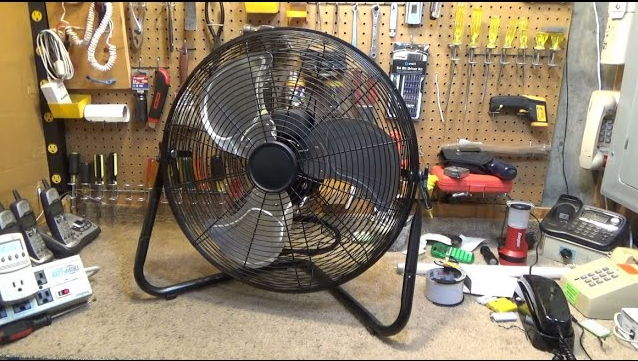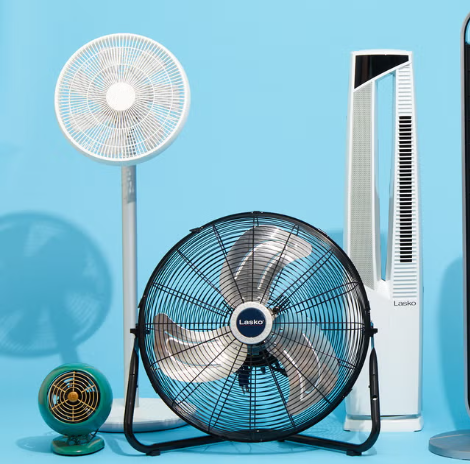When searching for affordable yet effective cooling solutions, Midea electric fans stand out for their modern design, smart features, and reliable performance. This Midea electric fan review explores the top Midea models for 2025, evaluating their cooling power, functionality, and value. From electric fan setup to electric fan troubleshooting, we’ll guide you in determining if a Midea fan is the best electric fan for your home or office. Our electric fan tips will help you optimize cooling efficiency and maintain long-term performance.
Why Choose a Midea Electric Fan?
Midea electric fans are designed to deliver strong airflow, ranging from 500 to 2500 CFM, suitable for small to large rooms. Known for their quiet operation (as low as 25 dB) and smart connectivity via the MSmartHome app, these fans offer modern convenience. Consuming 20-70 watts (about 1-2 cents per hour), they’re energy-efficient compared to air conditioners. With features like wide oscillation, timers, and air purification, Midea fans blend functionality with sleek aesthetics. This Midea electric fan review assesses whether these fans meet your cooling needs with practical benefits and minimal drawbacks.
Pros of Midea Electric Fans
Midea fans offer several advantages that make them a compelling choice. Here are the key benefits:
-
- Affordable Pricing: Ranging from $50-$150, Midea fans are cost-effective compared to premium brands like Dyson ($250-$800).
- Strong Airflow: Delivering 500-2500 CFM, they effectively cool rooms from 100 to 400 sq ft, suitable for various spaces.
- Quiet Operation: Many models operate at 25-40 dB on low settings, ideal for bedrooms or offices, with sleep modes for minimal disturbance.
- Smart Features: Wi-Fi-enabled models with MSmartHome app and Alexa/Google Assistant compatibility allow remote and voice control.
-
- Air Purification: Select models, like the AMS150-PB, include HEPA filters and plasma ion technology for cleaner air, meeting stringent standards.
-
- Versatile Designs: Options include tower, pedestal, and desk fans, with features like 60-135 degree oscillation and adjustable height for flexibility.
- User-Friendly: Timers (7-15 hours), remotes, and multiple speed settings (3-12) enhance convenience and energy savings.
These pros make Midea fans a great choice for budget-conscious buyers seeking modern, efficient cooling.
Cons of Midea Electric Fans
Despite their strengths, Midea fans have some limitations. Here are the key drawbacks:
-
- Noise at High Speeds: Some models can reach 50-60 dB on high settings, which may disrupt sleep or quiet environments.
- Limited Airflow for Large Spaces: Certain models (e.g., desk fans) offer lower CFM (500-1000), less effective for rooms over 400 sq ft.
- Plastic Construction: Many use plastic, which may feel less durable than metal and show wear over time.
- Complex Cleaning: Internal blades or filters can be hard to access, and HEPA filter replacements may be difficult to source.
-
- Smart Feature Issues: Some users report connectivity problems with the MSmartHome app or Alexa integration.
-
- Power Cord Issues: The cord may detach easily when moving the fan, requiring frequent re-plugging.
- Basic Models Lack Features: Entry-level models may lack timers or smart controls, limiting convenience.
These cons highlight the need to align the fan’s features with your specific needs.
Electric Fan Setup: Getting Started
Proper electric fan setup ensures your Midea fan performs optimally. Follow these steps:
-
- Unpack and Inspect: Verify all components, including the base, remote, and filters, are included and undamaged.
- Assemble Securely: Attach the base with screws or clips as per the manual, ensuring stability (e.g., MFS4022WARB’s adjustable height base).
- Position Strategically: Place on a flat surface in a corner or near a window to maximize airflow. Avoid obstructions like furniture.
- Plug In and Test: Connect to power, pair with the MSmartHome app (if applicable), and test speeds, oscillation, and timer settings.
Positioning opposite a wall or at a 90-degree angle enhances air circulation. Ensure stability to prevent tipping around children or pets.

How to Use a Midea Electric Fan Effectively
Maximize cooling with these electric fan tips:
-
- Use Oscillation: Enable 60-135 degree oscillation to distribute air evenly across the room.
-
- Create a Cross-Breeze: Place near an open window to pull in cooler air or pair with a bowl of ice for a chilled effect.
- Adjust Speeds: Use low speeds (1-5) for quiet operation during sleep and high speeds (6-12) for rapid cooling.
- Leverage Timers: Set timers (7-15 hours) to save energy, especially for nighttime use.
-
- Use Smart Controls: Control via the MSmartHome app or voice commands (e.g., “Alexa, turn off the fan at midnight”) for convenience.
Pairing with an air conditioner can enhance cooling, allowing you to raise the AC temperature and save energy.
Electric Fan Maintenance: Keeping Your Midea in Top Shape
Regular electric fan maintenance ensures longevity and performance. Follow these steps:
-
- Clean Regularly: Dust on blades or filters reduces airflow. See our electric fan cleaning guide below.
- Inspect Cords: Check for fraying or damage to the power cord or plug, ensuring secure connections. Stop using if issues are found.
- Tighten Components: Secure loose screws or parts to prevent vibration or wobbling.
- Store Properly: Store in a dry, dust-free area to protect components and prevent corrosion.
Consistent maintenance minimizes issues like dust buildup or filter clogs.
How to Clean a Midea Electric Fan
Electric fan cleaning is crucial for maintaining airflow and air quality. Here’s how to clean your Midea fan:
-
- Unplug the Fan: Disconnect from power to ensure electric fan safety.
- Remove Grilles or Filters: Unscrew or unclip grilles or HEPA filters as per the manual (e.g., AMS150-PB filters).
- Clean Blades: Vacuum dust or wipe blades with a dry cloth. Use a slightly damp cloth with mild soap for stubborn dirt, avoiding electronics.
- Wash Grilles/Filters: Soak removable grilles in warm, soapy water, scrub gently, and dry thoroughly. Clean or replace HEPA filters as needed.
- Reassemble and Test: Reassemble and test all functions to confirm proper operation.
Clean every 2-4 weeks during heavy use to prevent dust buildup and maintain air purification.
Electric Fan Troubleshooting: Fixing Common Issues
Even the best electric fan may encounter issues. Here’s a guide to electric fan troubleshooting for Midea models:
-
- Fan Won’t Start: Check the power cord, plug, or outlet. Ensure the cord is securely connected. Test the outlet with another device.
-
- Weak Airflow: Dust buildup or clogged filters can reduce performance. Clean blades or replace filters thoroughly.
- Excessive Noise: Loose parts or debris may cause rattling. Tighten screws or remove obstructions.
- Smart Feature Issues: If the app or Alexa fails, reset Wi-Fi or contact Midea support at [email protected].
If issues persist, contact Midea’s customer service or check the warranty (typically 1 year).
Electric Fan Safety: Staying Safe
Electric fan safety is critical, especially for bladeless models. Follow these guidelines:
-
- Avoid Water: Keep fans away from water or damp areas to prevent electrical hazards.
- Child and Pet Safety: Bladeless models (e.g., AMS150-PB) are safer, but ensure traditional fans have tight grilles to prevent access to blades.
- Limit Continuous Use: Use timers to avoid overnight operation, reducing overheating risks.
- Inspect Regularly: Check cords and components for wear, ensuring secure connections before use.
These precautions ensure safe operation of your Midea fan.

Top Midea Electric Fans for 2025
Based on recent testing and user feedback, here are the top Midea electric fans for 2025, evaluated for cooling power, features, and value:
-
- Midea 41″ Bladeless Tower Fan & HEPA Air Purifier (AMS150-PB): This 41-inch tower fan (8 x 8 x 41 inches, 10.8 pounds) delivers 1000-1500 CFM with 10 speeds, 60-degree oscillation, and a 12-hour timer. Its HEPA filter and plasma ion technology purify air, and it’s quiet at 25-40 dB. Users praise its cool airflow and sleek design, though filter replacements can be hard to find. Pros: Quiet, air purification, stylish. Cons: Moderate airflow, filter availability issues. Best for: Allergy sufferers in medium rooms.
-
- Midea 42″ Smart Tower Fan (MFT1021CRWB): This 42-inch fan (10 x 10 x 42 inches, 9 pounds) offers 1000-1500 CFM with three speeds, 60-degree oscillation, and a 7-hour timer. Wi-Fi-enabled with Alexa/Google Assistant, it includes an aroma diffuser and ionizer. Users love its smart controls but note occasional app issues. Pros: Smart, quiet (30-50 dB), affordable ($70-$100). Cons: Connectivity issues, moderate airflow. Best for: Tech-savvy users in medium rooms.
-
- Midea 16″ Smart Stand Fan (MFS4022WARB): This 16-inch pedestal fan (15.75 x 17.83 x 51.18 inches, 12.3 pounds) delivers 1500-2000 CFM with 12 speeds, 85-degree oscillation, and a 12-hour timer. Its DC motor ensures quiet operation (30-50 dB), with smart app/voice control. Pros: Powerful, quiet, adjustable height. Cons: Complex cleaning, plastic build. Best for: Large rooms needing strong airflow.
-
- Midea 6″ Table Fan (Unnamed Model): This compact desk fan (6 x 6 x 10 inches, ~2 pounds) offers 500-800 CFM with five speeds and 85-degree oscillation. Quiet at 30 dB, it’s ideal for small spaces but lacks smart features. Pros: Affordable ($50-$60), portable, quiet. Cons: Limited range, no smart controls. Best for: Personal desk cooling.
-
- Midea 42″ 5-Speed Tower Fan (MSFT42RW6BL): This 42-inch fan (10 x 10 x 42 inches, 9 pounds) provides 1000-1500 CFM with five speeds and wide-angle oscillation. Its detachable grille simplifies cleaning, though it lacks smart features. Pros: Easy to clean, quiet (30-50 dB). Cons: No smart controls, moderate airflow. Best for: Medium rooms on a budget.
These models balance affordability, performance, and modern features, though maintenance and connectivity issues may arise.
Conclusion: Is a Midea Electric Fan Right for You?
This Midea electric fan review highlights the strengths and weaknesses of Midea’s top models for 2025. With quiet operation, smart features, and air purification, they’re ideal for budget-conscious buyers seeking modern cooling solutions. However, noise at high speeds, complex cleaning, and occasional connectivity issues may be drawbacks. By mastering electric fan setup, electric fan cleaning, and electric fan troubleshooting, you can maximize performance. Prioritize electric fan safety and electric fan maintenance to ensure longevity. Whether you choose the AMS150-PB for air purification or the MFS4022WARB for powerful airflow, Midea offers reliable cooling for diverse needs.